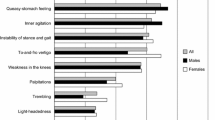Abstract
The distressing phenomenon of visual height intolerance (vHI) occurs when a visual stimulus causes apprehension of losing control of balance and falling from some height. Epidemiological data of this condition in the general population are lacking. Assignment of prevalence, determinants, and compensation of vHI was performed in a cross-sectional epidemiological study of 3,517 individuals representing the German population. Life-time prevalence of vHI is 28 % (females 32 %). A higher prevalence is associated independently with a family history of vHI, anxiety disorders, migraine, or motion sickness susceptibility. Women aged 50–59 have a higher prevalence than younger women or men of all ages. Initial attacks occur most often (30 %) in the second decade; however, attacks can manifest throughout life. The main symptoms are fearfulness, inner agitation, a queasy-stomach feeling, subjective postural instability with to-and-fro vertigo, and weakness in the knees. Climbing a tower is the first most common precipitating stimulus; the spectrum of such stimuli widens with time in more than 50 % of afflicted individuals. The most frequent reaction to vHI is to avoid the triggering stimuli (>50 %); 11 % of susceptible individuals consult a doctor, most often a general practitioner, neurologist, ENT doctor, or psychiatrist. In brief, visual height intolerance affects one-third of the general population, considerably restricting the majority of these individuals in their daily activities. The data show that the two terms do not indicate a categorical distinction but rather a continuum from slight forms of visual height intolerance to the specific phobia of fear of heights.



Similar content being viewed by others
References
Agras S, Sylvester D, Oliveau D (1969) The epidemiology of common fears and phobia. Compr Psychiatry 10:151–156
American Psychiatric Association, Committee on Nomenclature and Statistics (2000) Diagnostic and Statistical Manual of Mental Disorders, 4th edn, text revision. American Psychiatric Press, Washington, DC
Balaban CD, Jacob RG (2001) Background and history of the interface between anxiety and vertigo. J Anxiety Disord 15:27–51
Bauer M, Huppert D, Brandt T (2012) Fear of heights in ancient China. J Neurol 259:2223–2225
Becker ES, Rinck M, Türke V et al (2007) Epidemiology of specific phobia subtypes: findings from the Dresden Mental Health Study. Eur Psychiatry 22:69–74
Bles W, Kapteyn TS, Brandt T, Arnold F (1980) The mechanism of physiological height vertigo. II. Posturography. Acta Otolaryngol 89:534–540
Brandt T, Arnold F, Bles W, Kapteyn TS (1980) The mechanism of physiological height vertigo. I. Theoretical approach and psychophysics. Acta Otolaryngol 89:513–523
Brandt T, Benson J, Huppert D (2012) What to call “non-phobic” fear of heights? Br J Psychiatry 190:81. doi:10.1192/bjp.190.1.81a
Brandt T, Strupp M, Huppert D (2012) Height intolerance: an underrated threat. J Neurol 259:759–760
Coelho CM, Wallis G (2010) Deconstructing acrophobia: physiological and psychological precursors to developing a fear of heights. Depress Anxiety 27:864–870
Curtis GC, Magee WJ, Eaton WW, Wittchen HU (1998) Specific fears and phobias. Epidemiology and classification. Br J Psychiatry 173:212–217
Darwin E (1803) Zoonomia or, the laws of organic life, Volume I. Reprint of initial issue (2009), Scholars Publishing, Cambridge
De Girolamo G, Polidori G, Morosini P et al (2006) Prevalence of common mental disorders in Italy. Results from the European Study of the Epidemiology of Mental Disorders (ESENeD). Soc Psychiatry Psychiatr Epidemiol 41:853–861
Depla MF, ten Have ML, van Balkom AJ, de Graaf R (2008) Specific fears and phobias in the general population: results from the Netherlands Mental Health Survey and Incidence Study (NEMESIS). Soc Psychiatry Psychiatr Epidemiol 43:200–208
Furman JM, Balaban CD, Jacob RG, Marcus DA (2005) Migraine-anxiety related dizziness (MARD): a new disorder? J Neurol Neurosurg Psychiatry 76:1–8
LeBeau RT, Glenn D, Liao B et al (2010) Specific phobia: a review of DSM-IV specific phobia and preliminary recommendations for DSM-V. Depress Anxiety 27:148–167
Neuhauser H, Ellert U, Ziese T (2005) Chronic back pain in the general population in Germany 2002/2003: prevalence and highly affected population groups. Gesundheitswesen 67:685–693
Öst LG (2009) Spezifische Phobien. In: Margraf J (ed) Lehrbuch der Verhaltenstherapie, vol 2. Springer, Berlin Heidelberg New York, pp 29–42
Oosterink F, de Jongh A, Hoogstraten J (2009) Prevalence of dental fear and phobia relative to other fear and phobia types. Eur J Oral Sci 117:135–143
Rennert H (1990) Höhenschwindel, Höhenangst und Höhenphobie. Psychiatr Neurol Med Psychol (Leipzig) 42:333–339
Salassa JR, Zapala DA (2009) Love and fear of heights: the pathophysiology and psychology of height imbalance. Wilderness Environ Med 20:378–382
Stefanucci JK, Proffitt DR (2009) The roles of altitude and fear in the perception of height. J Exper Psychol Hum Percept Perform 35:424–438
Steyerberg EW, Eijkemans MJ, Harrell FE Jr et al (2001) Prognostic modeling with logistic regression analysis: in search of a sensible strategy in small data sets. Med Decis Making 21:45–56
Stinson F, Dawson D, Chou S et al (2007) The epidemiology of DSM-IV specific phobia in the USA: result from the National Epidemiologic Survey on Alcohol and Related Conditions. Psychol Med 37:1047–1059
Teachman BA, Stefanucci JK, Clerkin EM, Cody MW, Proffitt DR (2008) A new mode of fear expression: perceptual bias in height fear. Emotion 8:296–301
von Brevern M, Neuhauser H (2011) Epidemiological evidence for a link between vertigo and migraine. J Vest Res 21:299–304
Walk RD, Gibson EJ, Tighe TJ (1957) Behaviour of light-and-dark-reared rats on a visual cliff. Science 126:80–81
Walk RD, Gibson EG (1961) A comparative and analytical study of visual depth perception. Psychol Monogr 75 (15, whole no. 519)
Williams SL, Dooseman G, Kleifeld E (1984) Comparative effectiveness of guided mastery and exposure treatments for intractable phobias. J Consult Clin Psychol 52:505–518
World Health Organisation (1993) The ICD-10 Classification of Mental and Behavioral Disorders, Clinical Description and Diagnostic Guidelines. WHO, Geneva
Acknowledgments
The authors thank Judy Benson for copyediting the manuscript. The study was supported by the German Ministry of Education and Research, the IFBLMU , and the Hertie Foundation.
Conflicts of interest
None.
Ethical standard
All human studies must state that they have been approved by the appropriate ethics committee and have therefore been performed in accordance with the ethical standards laid down in the 1964 Declaration of Helsinki.
Author information
Authors and Affiliations
Corresponding author
Electronic supplementary material
Below is the link to the electronic supplementary material.
Rights and permissions
About this article
Cite this article
Huppert, D., Grill, E. & Brandt, T. Down on heights? One in three has visual height intolerance. J Neurol 260, 597–604 (2013). https://doi.org/10.1007/s00415-012-6685-1
Received:
Revised:
Accepted:
Published:
Issue Date:
DOI: https://doi.org/10.1007/s00415-012-6685-1




